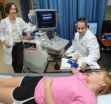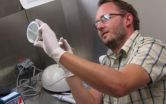(Press-News.org) In a commentary to be published in the Dec. 12 issue of The Journal of the American Medical Association, two Johns Hopkins faculty members predict an ever-diminishing role for government and drug company funding of basic biomedical research and suggest scientists look to "innovative" kinds of private investment for future resources. Current negotiations in Washington over sequestration and the so-called "fiscal cliff" provide an opportunity to fundamentally rethink the funding of biomedical research, they say.
Pointing to a decade of flat government funding for biomedical research, higher-than-ever costs of clinical trials, reduced drug industry investment and the threat of deep cuts to the federal research budget without congressional action by January to stop them, the commentators warn that without "creative" new sources of funding, biomedical innovation faces a crisis.
"Regardless of what happens in Congress, biomedical research must look to the private sector and not the federal government as the source of new funds," write Hamilton Moses III, M.D., an adjunct professor of neurology and onetime chief physician of The Johns Hopkins Hospital, and E. Ray Dorsey, M.D., M.B.A., an associate professor of neurology at the Johns Hopkins University School of Medicine.
"The uncertainty of federal support of biomedical research now and in the near-term only makes the need to look to the private sector for support more certain," adds Dorsey.
Moses and Dorsey also have business experience, on top of their medical credentials. Moses, a management consultant, runs the Alerion Institute, which conducts studies on research policy, and Alerion Advisors, LLC, which advises nonprofits and corporate boards on strategy, organization and governance. Dorsey is an associate professor at the Johns Hopkins Carey Business School.
Moses says the National Institutes of Health, which supports $32 billion a year for research, has already reduced the proportion of grants to individual investigators — the historical producers of most biomedical advances — and is focusing instead on collaborations, multicenter clinical trials and large-scale projects such as the Human Genome Project.
Inflation associated with conducting research at universities is running at three to four times the base U.S. rate of inflation, decreasing the amount of research by one-third every three years, he adds.
Meanwhile, Moses and Dorsey say, the pharmaceutical and drug device companies — which spend roughly two-thirds of the estimated $100 billion spent each year on biomedical research in the United States — are focused on large clinical trials and late-stage research, rather than the basic research that fuels future innovation. He says they are, understandably, spending research dollars on projects most likely to yield short-term returns, even at the expense of investment in diseases that are severe, common and cannot be prevented or treated effectively.
Noting that only 5 percent of research funding comes from private charities and foundations — resources already strained — Moses says the best way forward is to create new forms of funding, such as mutual funds for individual and institutional investors, "Biomedical Research Bonds," or patent pools to share risks and rewards inherent in innovation and technology transfer.
"These measures are analogous to those used to build sports arenas, ports, bridges or highways, lessening the financial burden on government," the Hopkins experts write. "They also promise to lower barriers that prevent collaboration between competing universities, companies and researchers."
Some areas of science, such as basic biology and mechanisms of disease, will likely never yield financial value to its discoverer, and consequently should continue to be the major focus of the NIH, Moses says.
But to realize the benefits of translational research and the development of marketable new therapies and good businesses, funding must increasingly come from sources other than the government. Moses' idea is to create new financial instruments that invite individuals, investors or pension funds to invest in research bonds that help cover the cost of making new scientific discoveries. Such bonds would draw not only those looking for financial rewards, but also those with a personal stake in a disease, a willingness to delay financial returns or a desire to help others. Buying a "cancer bond" or an "autism bond" has appeal for many, he adds.
"These bonds may not return anything in five to 10 years, or ever," says Moses, who believes raising $10 billion a year or more this way is doable. "Science is a form of speculation and the risk of failure is quite high. Yet it's precisely the high-risk, high-reward scientific endeavors that aren't getting funded anymore. We need to find a way to ensure they are. Clinical need and scientific opportunity far outstrip our current ability to support innovation."
### END
Federal government and big pharma seen as increasingly diminished source of research funding
Private investment must fill the gap, say 2 Johns Hopkins faculty members
2012-11-26
ELSE PRESS RELEASES FROM THIS DATE:
Researchers identify cause of anethesia-associated seizures
2012-11-26
Antifibrinolytic drugs are frequently used to prevent blood loss during surgery, but sometimes cause convulsive seizures. In this issue of the Journal of Clinical Investigation, researchers led by Beverly Orser at the University of Toronto investigated the molecular mechanisms that underlie this side effect. By studying antifibrinolytics in mice, Orser and colleagues found that the drugs inhibited the activity of glycine receptors in the brain, leading to seizures. Seizures could be prevented by co-treatment with the general anesthetic isoflurane. This study explains the ...
Bariatric surgical procedures have similar therapeutic benefits in obese adults
2012-11-26
Obesity is associated with insulin resistance and type 2 diabetes, both of which can be significantly improved by weight loss. Gastric bypass and adjustable gastric banding are two bariatric surgery techniques that are frequently used to effect weight loss in obese patients, but it is unclear if the two procedures produce different outcomes. In this issue of the Journal of Clinical Investigation, researchers led by Samuel Klein at the University of Washington School of Medicine in St. Louis compared the effects of 20% weight loss induced by either gastric bypass or adjustable ...
JCI early table of contents for Nov. 26, 2012
2012-11-26
Bariatric surgery procedures have similar therapeutic benefits in obese adults
Obesity is associated with insulin resistance and type 2 diabetes, both of which can be significantly improved by weight loss. Gastric bypass and adjustable gastric banding are two bariatric surgery techniques that are frequently used to effect weight loss in obese patients, but it is unclear if the two procedures produce different outcomes. In this issue of the Journal of Clinical Investigation, researchers led by Samuel Klein at the University of Washington School of Medicine in St. Louis ...
Old habits die hard: Helping cancer patients stop smoking
2012-11-26
ANN ARBOR—It's a sad but familiar scene near the grounds of many medical campuses: hospital-gowned patients, some toting rolling IV poles, huddled in clumps under bus shelters or warming areas, smoking cigarettes.
Smoking causes 30 percent of all cancer deaths and 87 percent of all lung cancer deaths. Yet, roughly 50 percent to 83 percent of cancer patients keep smoking after a cancer diagnosis, through treatment and beyond, says Sonia Duffy, University of Michigan School of Nursing researcher. For patients who quit on their own, relapse rates (as in the general population) ...
Corporate wrongdoers should stick to the facts in post-crisis message
2012-11-26
When faced with scandal or wrongdoing, corporations should stick to the facts in their post-crisis messaging, according to a new study from researchers at Rice University, the University of Georgia and the University of Maryland – College Park.
The study, "Managing the message: The effects of firm actions and industry spillovers on media coverage following wrongdoing," examined quarterly media coverage of 45 U.S. public toy companies a 10-year period and over 5,500 press releases generated by the companies during that time.
Almost half of the companies surveyed conducted ...
Risk aversity visible in the brain
2012-11-26
Some people live their lives by the motto "no risk - no fun!" and avoid hardly any risks. Others are clearly more cautious and focus primarily on safety when investing and for other business activities. Scientists from the University of Bonn in cooperation with colleagues from the University of Zurich studied the attitudes towards risk in a group of 56 subjects. They found that in people who preferred safety, certain regions of the brain show a higher level of activation when they are confronted with quite unforeseeable situations. In addition, they do not distinguish as ...
Impaired blood vessel function found in cystic fibrosis patients
2012-11-26
AUGUSTA, Ga. – The first evidence of blood vessel dysfunction has been found in a small cohort of generally healthy young people with cystic fibrosis, researchers report.
"Even though the lung function in these kids is fine at this point, there is evidence of vascular dysfunction and exercise intolerance," said Dr. Ryan A. Harris, clinical exercise physiologist at the Medical College of Georgia and Institute of Public and Preventive Health at Georgia Health Sciences University. "We think this blood vessel dysfunction could be contributing to their exercise intolerance, ...
Microbial 'missing link' discovered after man impales hand on tree branch
2012-11-26
It all started with a crab apple tree.
Two years ago, a 71-year-old Indiana man impaled his hand on a branch after cutting down a dead tree. The wound caused an infection that led scientists to discover a new bacterium and solve a mystery about how bacteria came to live inside insects.
On Oct. 15, 2010, Thomas Fritz, a retired inventor, engineer and volunteer firefighter, cut down a dead, 10-foot-tall crab apple tree outside his home near Evansville, Ind.
As he dragged away the debris, he got tangled in it and fell. A small branch impaled his right hand in the fleshy ...
Water resources management and policy in a changing world: Where do we go from here?
2012-11-26
Visualize a dusty place where stream beds are sand and lakes are flats of dried mud. Are we on Mars? In fact, we're on arid parts of Earth, a planet where water covers some 70 percent of the surface.
How long will water be readily available to nourish life here?
Scientists funded by the National Science Foundation's (NSF) Dynamics of Coupled Natural and Human Systems (CNH) program are finding new answers.
NSF-supported CNH researchers will address water resources management and policy in a changing world at the fall meeting of the American Geophysical Union (AGU), ...
Burning more calories is easier when working out with someone you perceive as better
2012-11-26
MANHATTAN, Kan. -- The key to motivation in physical activity may be feeling inadequate. One Kansas State University researcher found that those who exercised with a teammate whom they perceived to be better increased their workout time and intensity by as much as 200 percent.
Brandon Irwin, assistant professor of kinesiology, was the principle investigator in a study that tested whether individuals engage in more intense physical activity when alone, with a virtual partner or competing against a teammate.
"People like to exercise with others and make it a social activity," ...
LAST 30 PRESS RELEASES:
Making lighter work of calculating fluid and heat flow
Normalizing blood sugar can halve heart attack risk
Lowering blood sugar cuts heart attack risk in people with prediabetes
Study links genetic variants to risk of blinding eye disease in premature infants
Non-opioid ‘pain sponge’ therapy halts cartilage degeneration and relieves chronic pain
AI can pick up cultural values by mimicking how kids learn
China’s ecological redlines offer fast track to 30 x 30 global conservation goal
Invisible indoor threats: emerging household contaminants and their growing risks to human health
Adding antibody treatment to chemo boosts outcomes for children with rare cancer
Germline pathogenic variants among women without a history of breast cancer
Tanning beds triple melanoma risk, potentially causing broad DNA damage
Unique bond identified as key to viral infection speed
Indoor tanning makes youthful skin much older on a genetic level
Mouse model sheds new light on the causes and potential solutions to human GI problems linked to muscular dystrophy
The Journal of Nuclear Medicine ahead-of-print tip sheet: December 12, 2025
Smarter tools for peering into the microscopic world
Applications open for funding to conduct research in the Kinsey Institute archives
Global measure underestimates the severity of food insecurity
Child survivors of critical illness are missing out on timely follow up care
Risk-based vs annual breast cancer screening / the WISDOM randomized clinical trial
University of Toronto launches Electric Vehicle Innovation Ontario to accelerate advanced EV technologies and build Canada’s innovation advantage
Early relapse predicts poor outcomes in aggressive blood cancer
American College of Lifestyle Medicine applauds two CMS models aligned with lifestyle medicine practice and reimbursement
Clinical trial finds cannabis use not a barrier to quitting nicotine vaping
Supplemental nutrition assistance program policies and food insecurity
Switching immune cells to “night mode” could limit damage after a heart attack, study suggests
URI-based Global RIghts Project report spotlights continued troubling trends in worldwide inhumane treatment
Neutrophils are less aggressive at night, explaining why nighttime heart attacks cause less damage than daytime events
Menopausal hormone therapy may not pose breast cancer risk for women with BRCA mutations
Mobile health tool may improve quality of life for adolescent and young adult breast cancer survivors
[Press-News.org] Federal government and big pharma seen as increasingly diminished source of research fundingPrivate investment must fill the gap, say 2 Johns Hopkins faculty members


